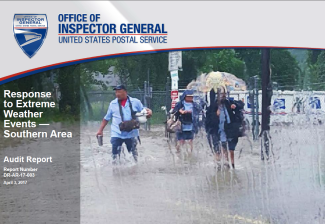Response to Extreme Weather Events — Southern Area
Background
In 2016, the U.S. Postal Service’s Southern Area was impacted by extreme weather events that inundated large areas with severe flooding, wind damage, and storm surges. Two land-based storms impacted the Houston and Louisiana districts with rapid and unpredictable flash flooding. One of the storms in Louisiana poured 7 trillion gallons of rain in the area in three days — three times more rain than did Hurricane Katrina. This flood has been called the worst natural disaster in the U.S. since Hurricane Sandy.
In addition, the Southern Area’s Gulf Atlantic District experienced two hurricanes — Hermine and Matthew — that made landfall in or otherwise impacted the southeastern U.S., flooding large areas from Florida through the Carolinas. The Gulf Atlantic, Louisiana, and Houston districts combined account for 654 post offices containing 12,872 routes and 11,998 vehicles that deliver to 8.1 million delivery points. The extreme weather events caused damage to some postal vehicles and mail.
In the Gulf Atlantic District, two different processing and distribution centers lost power for about two days as a result of hurricanes making landfall. This resulted in about 1.7 million delayed mailpieces at the Tallahassee P&DC and 8.8 million delayed mailpieces at the Jacksonville P&DC over that two-day period. Extreme weather events also impacted individual post offices.
On August 13, 2016, the Denham Springs Post Office in the Louisiana District was flooded as a result of extremely heavy localized rainstorms. The facility received heavy damage and was unable to reopen following the flooding. Thirty days prior to the flooding, the facility reported no delayed mail. The facility later reported about 422,000 delayed mailpieces.
In September 2013, the Postal Service deployed an Integrated Emergency Management Plan for customer service sites. According to Southern Area officials, this plan was updated in 2015 to include area, district, and facility management to help prepare for, respond to, and recover from emergencies.
Our objective was to evaluate the effectiveness of the Southern Area’s actions to safeguard the mail and delivery vehicles in response to extreme weather events in 2016.
What the OIG Found
The Southern Area responded effectively to safeguard the mail and delivery vehicles by following its emergency management plan to mitigate the effects of extreme weather events in the Gulf Atlantic, Houston, and Louisiana districts that occurred in a six-month time frame in 2016.
Specifically, area and district personnel implemented emergency management preparedness plans for operations, monitored the weather on a daily basis (sometimes more frequently); provided guidance to the stations prior to the event; monitored operations before, during, and after these extreme events; and helped restore operations.
The Gulf Atlantic District had a small amount of mail damage, but no vehicle damage. The district followed the Integrated Emergency Management Plan checklists, held table top exercises, and updated emergency contact lists to prepare for these events. They also moved vehicles from seven units to protect them from possible storm related damage. The Houston District had no mail damage or vehicle loss. The district followed the Integrated Emergency Management Plan checklist for vehicle relocations and moved vehicles at one unit as a precautionary measure.
The Louisiana District had 45 vehicles and about 165,000 mailpieces damaged or destroyed at one unit as a result of flash flooding. The district used daily telecons to monitor weather conditions and made operational decisions as needed. For example, the district moved vehicles at one unit based on changing weather conditions in the area. Unexpected flash flooding at one unit prevented unit personnel from moving vehicles; however, mail in the unit at the time of the flooding was moved to the highest point possible to prevent further damage. The Southern Area incurred $193,871 in costs for vehicle repairs as a result of the flooding.
Postal Service management could not have anticipated the extent, severity, and speed of the flash flooding the storms produced in the Louisiana District. Southern Area management’s emergency preparedness, planning, and response minimized damage to vehicles and loss of mail during these extreme weather events.
What the OIG Recommended
Southern Area management’s appropriate and timely response to these weather events minimized damage and loss of mail and vehicles; therefore, we are not making any recommendations in this report.

